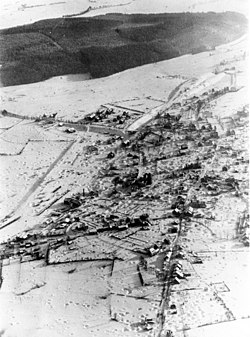Battle of St. Vith
| Battle of St. Vith | |||||||
|---|---|---|---|---|---|---|---|
| Part of Battle of the Bulge | |||||||
 St. Vith, Belgium |
|||||||
|
|||||||
| Belligerents | |||||||
|
|
|
||||||
| Commanders and leaders | |||||||
|
|
|
||||||
| Units involved | |||||||
| Strength | |||||||
| 22,000 men | 100,000+ men 500 tanks |
||||||
| Casualties and losses | |||||||
| 12,500 KIA, WIA, POW, or MIA 88 tanks, 25 armored cars |
Unknown | ||||||
The Battle of St. Vith was part of the Battle of the Bulge, which began on 16 December 1944, and represented the right flank in the advance of the German center, 5th Panzer-Armee (Armored Army), toward the ultimate objective of Antwerp.
The town of St. Vith, a vital road junction, was close to the boundary between the 5th and Sepp Dietrich’s Sixth Panzer Army, the two strongest units of the attack. St. Vith was also close to the western end of the Losheim Gap, a critical valley through the densely forested ridges of the Ardennes Forest and the axis of the entire German counteroffensive. Opposing this drive were units of the U.S. VIII Corps. These defenders were led by the U.S. 7th Armored Division and included the 424th Infantry (the remaining regiment of the 106th U.S. Infantry Division), elements of the 9th Armored Division's Combat Command B and the 112th Infantry of the U.S. 28th Infantry Division. These units, which operated under the command of Generals Robert W. Hasbrouck (7th Armored) and Alan W. Jones (106th Infantry), successfully resisted the German attacks, thereby significantly slowing the German advance.
...
Wikipedia
